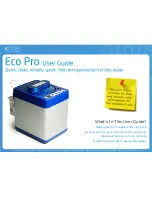
DUKE EASY S.T.01/3AW Rev.0 01/2017
15
4.
CONTROLS - ADJUSTMENTS - INDICATORS
SAFETY SYSTEMS
The dental chair is supplied with safety devices which minimise the risk of crushing or collision with
underlying objects during chair descent. Safety devices include a special sensor on the dental chair back
and an electromechanical safety device installed at the base of the dental chair back.
Whenever the sensor installed on the dental chair back is engaged during a descent movement (either of
the pantographic arm or chair back), the part moving down stops. A warning LED at the bottom of the
seat (detail B) goes ON and stays ON until the obstacle causing safety device engagement is cleared. To
perform the required movement, remove the obstacle and repeat the control.
The sensor installed on the back of the dental chair is calibrated as instructed below.
-
Place the chair in the permanent position;
-
Put a screwdriver in the hole for the calibration of the sensor located at the bottom of the chair seat
(detail B). Turn the screwdriver clockwise to reduce the sensor sensitivity and anticlockwise to
increase it.
-
Control the pantographic arm or chair back to move downwards and touch the back of the dental chair
to engage the safety sensor (detail A) in order to check its sensitivity. Repeat the operations from
the previous item until the ideal sensor sensitivity is found.
When the back safety sensor is engaged, all downward movements of both the back and pantographic arm
are disabled.
The back of the dental chair is also provided with an electric and mechanical safety device which stops
the descent movements of both the pantographic arm and back whenever obstacles are present in the
outreach of the keyboard. Whenever this safety device is engaged, all downward movements of both the
pantographic arm and back are disabled.
During automatic movements of the dental chair (position reset, memorised positions or rinsing positions),
press any control of the dental chair (on the pushbutton panels of the dental unit or foot control) to
immediately stop the dental chair.
Dental chair movement may be disabled both at equipment switch on and during normal operation, if one
or more than one safety system is active.















































